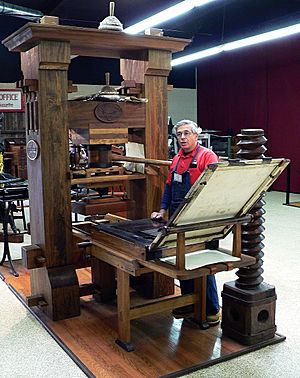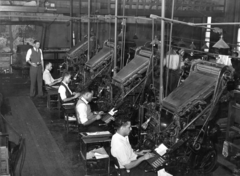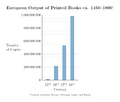Printing press facts for kids

The printing press is a special machine that makes many copies of the same page. Think of it like a super-fast stamp! Today, printing presses are used to create books, newspapers, and magazines. This amazing invention changed the world, especially in Europe.
Before the printing press, people used woodcut printing. This meant carving an entire page, including words and pictures, into a block of wood. It was a lot of work! In the 1400s, a clever inventor named Johannes Gutenberg made things much better. He created a way to use separate metal letters. These letters could be arranged to form any page, then taken apart and reused. This process was called typesetting. Each letter was a small metal block. Gutenberg would arrange these blocks in a frame, ink them, and then press paper onto them. This method, called letterpress, left ink on the paper, forming text and pictures.
Contents
How Printing Changed the World
The printing press made it much easier and faster to produce books. Before Gutenberg, books were copied by hand, which took a very long time. With the printing press, many copies could be made quickly and cheaply. This meant more people could afford books and learn to read. It helped spread new ideas, knowledge, and stories faster than ever before.
Printing in the Industrial Age
During the Industrial Revolution, printing presses got much bigger and faster. This happened mostly in the 1800s. Two big ideas completely changed how printing presses worked. First, machines started using steam power instead of human power. Second, the flat printing surface was replaced with spinning cylinders.
A German printer named Friedrich Koenig made these improvements between 1802 and 1818. He moved to London in 1804 and got money to support his ideas. In 1810, Koenig received a patent for a steam press. It was like a hand press but connected to a steam engine, making it much more powerful.
New Inventions for Printing
Many other inventions helped printing become even better. People found ways to make paper cheaper by using wood pulp instead of old rags. Later in the 1800s, machines were invented to speed up typesetting. Before, each letter had to be placed by hand.
A company called Linotype Inc. designed a machine for "hot metal typesetting." This machine would melt lead and turn it into ready-to-use type for printing. This made setting up pages much faster and easier.
Modern Printing Today
Many more printing developments happened in the 1900s. Today, printing presses are controlled by special computers. The text and pictures to be printed are all prepared on computers first. Because of these inventions, the cost of printing has dropped a lot. Now, the price of a book or magazine is less about how it's made and more about things like marketing and how it's sold.
Images for kids
-
Medieval university class (1350s)
-
Early modern wine press. Such screw presses were applied in Europe to a wide range of uses and provided Gutenberg with the model for his printing press.
-
Movable type sorted in a letter case and loaded in a composing stick on top
-
A paper codex of the acclaimed 42-line Bible, Gutenberg's major work
-
This woodcut from 1568 shows the left printer removing a page from the press while the one at right inks the text-blocks. Such a duo could reach 14,000 hand movements per working day, printing ca. 3,600 pages in the process.
-
"Modern Book Printing" sculpture, commemorating Gutenberg's invention on the occasion of the 2006 World Cup in Germany
-
Koenig's 1814 steam-powered printing press
-
Stanhope press from 1842
See also
 In Spanish: Imprenta para niños
In Spanish: Imprenta para niños


















